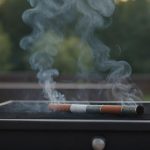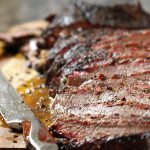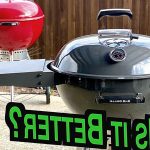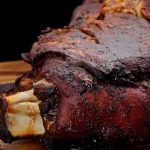Did you know that an improperly managed smoker can produce up to three times more smoke than necessary, often signaling a waste of fuel and potential food spoilage? For many home chefs and BBQ enthusiasts, mastering the art of smoking meat is a delightful challenge that marries the science of cooking with the ancient art of smoke curing.
However, excessive smoke can transform this culinary dance into a frustrating battle against billowing clouds, potentially leading to bitter, over-smoked food that’s hard to salvage.
Understanding why your smoker is acting more like a freight train than a refined cooking appliance is crucial not only for the quality of your meals but also for maintaining a safe and enjoyable cooking environment. Here’s what we’ll cover to help you tame the smoke and reclaim your title as the pitmaster:
- The role of fuel type and quality: How your choice of wood or charcoal can dramatically affect smoke output.
- Airflow management: Techniques to adjust vents and positioning to optimize smoke and heat.
- Maintenance tips: Routine checks and cleans to keep your smoker performing at its best.
- Temperature control: Understanding the thermal sweet spot for different meats to prevent overheating and excessive smoking.
With these insights, you’ll be equipped to reduce the smoke from your smoker, ensuring cleaner, tastier results every time.
Contents
Dirty Smoker
A dirty smoker contributes to excess smoke output primarily through the impediments it presents to the normal flow and regulation of air and smoke. This occurs due to the accumulation of grease, oil, and ash within its components. Here’s a breakdown of the primary culprits and the steps to mitigate such issues:
| Component | Problem | Solution |
| Chimney and Vents | Clogged with soot and creosote, impeding smoke outflow and causing buildup within the chamber. | Regular cleaning post-use, check for obstructions, and ensure clear pathways for air and smoke. |
| Grates and Interior Surface | Accumulation of grease and burnt remnants from previous BBQ sessions can increase smoke and flare-ups. | Scrub grates and interior surfaces after each use, using grill brushes and appropriate cleaners. |
| Fuel Quality | Poor-quality fuels burn inefficiently, producing excessive ash and particulates that clog airways. | Opt for high-quality charcoal or wood that is appropriate for the type of smoker and the food being cooked. |
Additionally, maintaining the overall integrity of your smoker is crucial. This involves checking for any gaps or leaks that might affect smoke distribution and ensuring the smoker is well-sealed and functions as designed.
Charcoal Ignition
Igniting charcoal in a smoker might seem straightforward, but common slip-ups can increase smoke production and affect the quality of your BBQ. Here are the typical errors and ways to avoid them:
- Choice of Charcoal: Using briquettes instead of lump charcoal can lead to more smoke. Briquettes often contain additives that produce excess smoke when burnt. Opt for natural lump charcoal for a cleaner burn.
- Excessive Lighter Fluid: Dousing the charcoal with too much lighter fluid not only creates a hazardous situation but also results in a ton of smoke. Use just enough to get the charcoal started or, better yet, use a chimney starter.
- Neglecting the Chimney Starter: Many BBQ enthusiasts skip using a chimney starter, but this tool can help evenly ignite the charcoal, reducing smoke. Simply fill the chimney with charcoal and light it from the bottom using a lighter or match.
- Uneven Charcoal Placement: Even if your charcoal is lit properly, piling it unevenly on the grill leads to inconsistent burning and excessive smoke. Ensure that the charcoal is spread evenly across the base of the smoker.
- Dirty Grill: Not cleaning the grill from previous uses can leave residues that burn and smoke excessively next time. Make sure to clean your grill to avoid this problem.
- Improper Ventilation: Sometimes the issue is with not managing the smoker’s airflow. Too little air can smother the charcoal and cause a lot of smoke. Adjust the vents to maintain a steady air flow and check them regularly.
Lack Of Oxygen

A lack of oxygen in a smoker plays a crucial role in causing an overabundance of smoke. When oxygen levels are insufficient, the combustion of wood or charcoal in the smoker is incomplete. This inefficient burning process leads to the production of thick, heavy smoke, which can negatively impact the flavor and quality of the food being smoked.
Proper airflow is essential to maintain an adequate supply of oxygen to the fire, ensuring that the fuel burns efficiently and cleanly, producing the desirable thin, blue smoke that imparts a rich, smoky flavor to the food.
Here’s a detailed look at the factors contributing to low oxygen levels in a smoker:
| Factor | Impact on Oxygen Levels | Resulting Issue |
| Improper Ventilation | Oxygen cannot adequately reach the combustion area. | Excessive, billowy smoke due to fuel burning inefficiently. |
| Dirty Smoker | Build-up of ash and debris restricts airflow. | Blocked vents prevent oxygen from fuelling the fire effectively. |
| Poor Airflow Design | Inadequate design hampers oxygen distribution. | Consistent over-production of smoke. |
| Use of Damp Wood | Wet wood requires more oxygen to burn. | Thick, white smoke that can alter food flavor negatively. |
To counteract these issues, ensure your smoker is well-ventilated, regularly cleaned, and uses dry, seasoned wood. This will facilitate a steady flow of oxygen, which is key to achieving the perfect smoke for BBQ.
Cooking Over Fire
| Mistake | Details | Impact |
| Overloading the Fuel | Adding too much wood or charcoal. | Creates excess, bitter smoke, imparting an unpleasant flavour. |
| Using Unseasoned Wood | Employing green or wet wood. | Results in thick, white smoke that is harmful and spoils the taste. |
| Poor Ventilation | Insufficient airflow in the smoker. | Leads to smoke accumulation and a bitter taste in food. |
| Skipping Preheat | Not heating the smoker before adding food. | Causes smoke to increase as the smoker heats up, affecting taste. |
| Improper Food Placement | Food placed too closely or stacked. | Blocks smoke flow, causing excess smoke production. |
| Frequent Lid Opening | Constant checking and stirring of food. | Loss of heat prompts more smoke to maintain temperature. |
| Low-Quality Fuel | Using substandard wood or charcoal. | Produces thick, black smoke, ruining food flavour and posing health risks. |
| Lack of Cleanliness | Not cleaning grease and ash buildup. | Obstructs airflow and causes uneven burning, increasing smoke. |
| Inexperience | Lack of practice and patience in smoking techniques. | Can easily lead to errors that result in too much smoke. |
These common errors in smoking techniques can significantly impair the quality of your BBQ, affecting both flavour and health.
Too Much Wood
| Mistake | Explanation | Impact on Smoking |
| Excessive Wood/Charcoal | Adding too much fuel in the form of wood or charcoal is a frequent misstep among novice smokers. | Leads to overwhelming smoke output, overpowering the natural flavors of the food. |
| Skipping Preheat | Not allowing the smoker to reach the desired temperature before cooking. | Causes residual oils or debris to smoke excessively when new fuel is added. |
| Using Wet or Green Wood | Employing wood that is not fully dried or seasoned. | Produces bitter, thick smoke that can spoil the taste of the meat. |
| Poor Airflow Management | Incorrect adjustment of the smoker’s vents. | If vents are too closed, it restricts air circulation, leading to smoke buildup; too open, it burns fuel too quickly, also increasing smoke. |
| Inadequate Cleaning | Failing to regularly clean the smoker to remove grease and residue. | Buildup on smoker surfaces can create excessive smoke, altering flavor quality. |
By steering clear of these pitfalls and fine-tuning your smoking technique, you’re set to master the art of BBQ with just the right kiss of smoke to your meats. Whether you’re a seasoned pitmaster or a keen weekend warrior, keeping these tips in mind ensures that your next barbecue is nothing short of spectacular.
Cleaning And Maintaining Your Smoker
To ensure your smoker operates efficiently and doesn’t overproduce smoke, regular maintenance is vital. Here’s a straightforward guide on how often to clean your smoker and the best methods to use:
Frequency of Cleaning:
- After Each Use: For all smoker types, remove ash, charcoal remnants, and food particles. This prevents buildup and maintains airflow.
- Annually: Conduct a thorough deep clean of your smoker. This includes disassembling where possible and scrubbing all components with soapy water to remove stubborn residues.
Cleaning Methods:
- Surface Cleaning: Regularly wipe down the interior and exterior surfaces with a soft cloth and a mild detergent. For tougher stains, use a solution of hot water and baking soda.
- Grate Cleaning: Use a grill brush to scrub the grates after each use. If residue persists, soak the grates in a mixture of vinegar and baking soda before scrubbing.
- Deep Cleaning: Once a year, disassemble your smoker for an in-depth clean. Soak removable parts in a soapy water solution, and use a scrubbing brush or pad to remove caked-on grease and food residue.
Maintenance Tips:
- Regularly inspect and clean vents and chimneys to prevent blockages.
- Replace any worn parts like gaskets and seals to keep the smoker airtight.
- Store your smoker covered and in a dry place to protect it from the elements and prevent rust.
Implementing these cleaning habits will keep your smoker in prime condition, ensuring that it produces just the right amount of smoke for perfect BBQ results every time.
| Part of Smoker | Cleaning Frequency | Cleaning Method |
| Interior surfaces | After each use | Wipe with mild detergent |
| Grates | After each use | Scrub with grill brush; soak if needed |
| Chimney and vents | Check monthly | Clean to prevent blockages |
Good Smoke vs Bad Smoke
Understanding the nuances between good smoke and bad smoke is vital for mastering the art of BBQ. Good smoke, often described as thin and blueish, carries a slightly sweet aroma that enhances the flavour of the meat. This is contrasted sharply by bad smoke, which is typically thick, white or black, and has an acrid smell that can overpower the natural flavours of the food.
| Type of Smoke | Description | Impact on BBQ |
| Good Smoke | Thin, blueish, sweet-smelling | Infuses meat with a desirable smoky flavour |
| Bad Smoke | Thick, white/black, acrid-smelling | Overpowers meat flavour, potential health hazards |
To ensure your smoker is producing the right amount of good smoke, consider these key steps:
- Choose the Right Fuel: Using the correct wood or charcoal that complements your food and smoker type is crucial. Avoid green or damp wood as it tends to produce a lot of bad smoke.
- Control Airflow and Temperature: Maintain a steady airflow using vents or dampers. This helps in achieving a consistent temperature, which is essential for good smoke production. Abrupt temperature changes can lead to bad smoke.
- Monitor Lid Opening: Keep the smoker lid closed as much as possible. Opening the lid frequently can disrupt the internal temperature and smoke balance, leading to bad smoke formation.
- Use a Water Pan: Place a water pan above the heat source. This helps in regulating the temperature and adds moisture to the environment, reducing the chances of bad smoke.
Conclusion
Managing smoke output in your smoker is key to achieving the perfect BBQ.
Excessive smoke often stems from a combination of factors such as poor fuel quality, inadequate airflow, lack of maintenance, and suboptimal temperature control. To mitigate these issues, selecting high-quality wood or charcoal and ensuring your smoker is clean and well-maintained are crucial steps.
Regularly cleaning components like the chimney, vents, and grates will prevent clogs and promote better airflow, which is essential for complete combustion and reduced smoke production. Additionally, mastering the control of air intake and exhaust and maintaining the right temperature can significantly improve your smoking process.
By addressing these common pitfalls, you ensure a safer, more enjoyable, and flavor-enhancing cooking experience, transforming every BBQ session into an opportunity to perfect the art of smoke curing.






